CDN vs. Edge Computing: Differences and Use Cases, What is MPEG-DASH Video Streaming Protocol? Latest OTT News and more
OTTVerse Newsletter #51
Hi everyone, and welcome back to the OTTVerse newsletter.
This week, we present:
Latest OTT News
Latest News from Streaming Tech Providers
CDN vs. Edge Computing: Differences and Use Cases
What is MPEG-DASH Video Streaming Protocol? How Does MPEG-DASH Work?
And more!
If you want to advertise on OTTVerse or collaborate with us on editorial material, please email abhi@ottverse.com.
Company Spotlight
In our Company Spotlight series, we highlight innovative companies that are driving transformation within the streaming industry.
Agora
Agora’s media and entertainment solutions empower content providers to deliver interactive live streaming and OTT experiences for sports, events, news, and live shopping. With the ability to stream from anywhere, including leveraging cost-effective user-generated content, Agora enhances platforms with interactive social features to boost engagement and retention.
It also enables new revenue streams through virtual events, live shopping, and tipping, while its ultra-low latency network ensures high-quality live content delivery globally, surpassing the limitations of traditional CDNs.
For more details, check out:
Latest OTT News
DirecTV Makes Satellite Ads Easier to Access - DirecTV Advertising has made its satellite TV ads available for programmatic buying. That is advertisers now bid for ad spots in real-time and run campaigns automatically on traditional TV, using DirecTV’s technology called DirecTV Axis.
Discovery+ starts 2025 with Price Hikes for Streaming Plans- Warner Bros. Discovery has started the new year by increasing the price of its streaming service, Discovery+, making it the first media company to announce such a hike in 2025.
Comcast and Paramount Global Secure Multi-Year Carriage Agreement- Comcast and Paramount Global have reached a new multi-year carriage agreement, ensuring that Paramount-backed networks such as CBS, BET, Comedy Central, MTV, Nickelodeon, and Paramount Network will remain available on Comcast’s cable systems
Roku Reaches 90 Million Streaming Homes in 2025 - Roku has announced that it has exceeded 90 million streaming households as of the first week of January 2025, an increase from 85.5 million in October 2024.
Amazon’s 2025 Upfront to Focus on Ad-Supported Media - Amazon has announced its plans to hold its 2025 upfront presentation on Monday, May 12, at 6:30 p.m. at The Beacon Theater in New York City.
Disney Takes Majority Control in Hulu Live TV and Fubo Merger- Disney has announced plans to merge its multichannel streaming service, Hulu + Live TV, with competitor Fubo in a deal to reshape the virtual multichannel video provider (vMVPD) market.
Spotify Launches New Monetization Program for Creators- Spotify has launched a new Partner Program specifically for podcast creators in the US, UK, Canada, and Australia.
Netflix’s Holiday Hits: Squid Game Season 2 and Live NFL Coverage- Netflix’s highly anticipated Squid Game Season 2 has made a massive impact, shattering records and dominating viewership charts globally.
Netflix’s NFL Christmas Day Games Break Streaming Records- Netflix’s exclusive airing of two NFL games on December 25th, 2024, attracted notable interest, marking a significant milestone for the streaming service’s entry into live sports.
Apple TV+ for Free This New Year’s Weekend- Apple is letting everyone stream Apple TV+ for free for the first weekend of the new year. From Friday, January 3, to Sunday, January 5, you can watch all their shows and movies without paying a single penny.
Latest From Streaming Tech Providers
Rakuten TV launches ‘NORDIC FILMS’, a new fast channel entirely dedicated to the best of Nordic Cinema- Rakuten TV, Europe’s streaming platform, has launched a new branded owned & operated FAST Channel, Nordic Films, dedicated to celebrating the very best of Nordics cinema.
For more OTT news and updates, please go to OTTVerse.com
CDN vs. Edge Computing: Differences and Use Cases
Speed, availability, and reliable user experiences are critical in the video streaming industry – live streaming, live shopping, VOD, or User-Generated Content. Consequently, technologies like Content Delivery Networks (CDN) and Edge Computing have emerged as crucial components to address these needs.
CDNs work by strategically placing a network of servers across various geographical locations, aiming to distribute the load of delivering content. When a user requests specific content, the request is redirected to the nearest CDN server instead of being routed to the central server (which could be thousands of miles away).
While Edge Computing and cloud computing offer remote data processing capabilities, their application and impact differ. In a conventional cloud setup, scalability and centralised management are the primary advantages. Edge Computing, in contrast, excels in scenarios where low latency and rapid response are crucial. By positioning processing capabilities closer to the data source, Edge reduces the time data spends in transit. This decentralised approach, while limiting raw processing power compared to massive cloud servers, offers unparalleled speed in real-time decision-making.
Krishna Rao Vijayanagar, founder of OTTVerse, shares details about CDN vs. Edge Computing: Differences and Use Cases: https://ottverse.com/cdn-vs-edge-computing-differences-usecases/
What is MPEG-DASH Video Streaming Protocol? How Does MPEG-DASH Work?
MPEG-DASH is one of the most popular video-streaming protocols and is widely used to deliver media either via Video on Demand (VOD) or Live Streaming and to various end-user devices, including smartphones, tablets, SmartTVs, gaming consoles, and more. MPEG-DASH is an HTTP-based streaming protocol for delivering video to the end-user from an HTTP server. In MPEG-DASH, a video is split into segments and this information is recorded in an MPD. The MPD is first delivered to the player, which uses it to request segments of the appropriate bitrate & resolution based on the network conditions and buffer fullness.
ABR or Adaptive Bitrate Streaming is used for dynamically varying the video bitrate and quality during streaming in response to the changes in bandwidth and buffer fullness at the player. However, it would be very hard to do this if the entire file was being streamed in one go. Imagine downloading a video file from Dropbox, S3, or Google Drive. It is a single file and will be treated as any other file – text, data, etc.
Many players support MPEG-DASH and cater to a variety of applications and devices. Some players are built to play MPEG-DASH videos on web browsers (HTML5), Android Exoplayer, Roku, SmartTV via native apps or web browsers, and more.
Krishna Rao Vijayanagar, founder of OTTVerse, shares What is MPEG-DASH Video Streaming Protocol? How Does MPEG-DASH Work?: https://ottverse.com/mpeg-dash-video-streaming-the-complete-guide/
The End
That brings us to the end, and we’ll return with more information next week.
Before you leave, please:
Subscribe to our LinkedIn page (and join 7600+ other video enthusiasts)
Join our WhatsApp group (900+ members) to participate in interesting conversations about the industry.
Subscribe to our YouTube channel.
Also, please subscribe to our newsletter by clicking the button below.




